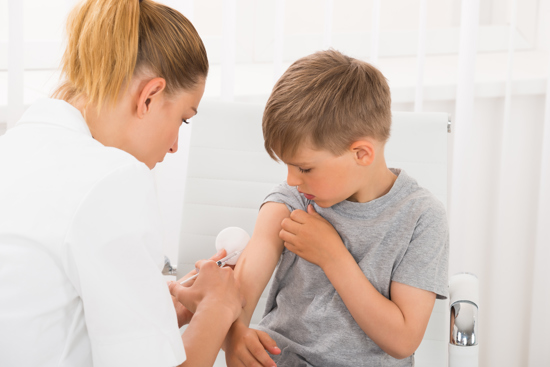The vaccine against diphtheria, tetanus, pertussis, poliomyelitis, Hib infection and hepatitis B is a six-component vaccine (six vaccines given at the same time so the child only needs one injection in the thigh).
After the three vaccine doses are given according to the programme (at 3, 5 and 12 months), children will have permanent protection against Hib infection and hepatitis B. For the other diseases, booster doses are given in school age.
About the six diseases the vaccine protects against
Diptheria
Diphtheria is a nose and throat infection caused by diphtheria bacteria. The bacteria produce toxins that can attack the heart, kidney and nervous tissue.
The disease can be fatal. During and just after the Second World War, there were diphtheria epidemics in Norway. After vaccination was introduced in 1952, only a few cases of the disease have occurred after infection abroad. Diphtheria continues to occur in parts of Europe and other parts of the world.
Tetanus
Tetanus is caused by a bacterium that can be found in soil. Infection occurs when the bacterium comes into contact with wounds. The disease is not transmitted from person to person.
The bacterium produces toxins that attack the nervous system and cause muscle stiffness and painful cramps. The disease has high mortality. It is less common in the Nordic countries than in warmer climates.
Whooping Cough (pertussis)
Whooping Cough (pertussis) is a prolonged (6–12 weeks) respiratory infection with severe bouts of coughing. Whooping cough can lead to brain damage due to lack of oxygen during coughing bouts, and in rare cases can be fatal.
It can be particularly dangerous for small children, particularly infants. In older children and adults, the disease can be prolonged and bothersome but is rarely life-threatening. The disease is highly contagious – nearly 100 per cent of the population contracted the disease before we started to vaccinate.
Poliomyelitis
Poliomyelitis is a viral disease that usually results in cold-like symptoms, body aches or diarrhoea. It can cause inflammation of the brain membrane (meningitis) and can lead to permanent paralysis. Fatalities do occur.
Before the vaccine arrived in 1957, there were annual polio epidemics in Norway in which several hundred children and adolescents were permanently paralysed. Up to 10 per cent died. Since vaccination was introduced, the disease is under control in Norway and several other countries. Europe was declared free of polio in 2002 but the disease still occurs in several countries in Africa and Asia. Unvaccinated people can become infected while travelling and can infect other unvaccinated people on their return.
Hib infection
Hib infection is caused by the Haemophilus influenzae type b (Hib) bacterium and was the most frequent cause of inflammation of the brain membrane (meningitis) in children under five in Norway before the vaccine became available. Hib can also cause other serious infections such as pneumonia, arthritis and epiglottitis. After vaccination was introduced in 1952, Hib infections are almost non-existent in Norway.
Hepatitis B
Hepatitis B is an inflammation of the liver caused by the hepatitis B virus. The virus is found in blood and body fluids. It cannot penetrate intact skin. Infection occurs through mucous membranes or broken skin, such as the injection site of a bloody syringe, a blood transfusion or sexual contact. Babies born to mothers infected with the disease are at risk of infection.
Among infected infants, over 90 per cent will have a chronic infection and become carriers of hepatitis B virus if they do not receive preventive care. The risk of becoming a chronic carrier decreases throughout childhood and is less than 5 per cent for those infected in adulthood. Throughout life, people with Down’s syndrome have a high risk of becoming chronic carriers because of impairments in their immune systems.
A chronic carrier state can lead to cirrhosis or liver cancer. Chronic carriers are also the main source of infection for hepatitis B so it is important to limit the number of new carriers as much as possible.
Children born to mothers who are carriers will follow a separate immunisation programme that starts within 24 hours after birth. Mothers who know that they are carriers should inform their midwife or public health nurse.

Why is vaccinaton important?
Vaccines are a simple and effective way to protect yourself against a number of dangerous and infectious diseases.
Illustration: Andrey Popov / Mostphotos
Common side effects of the vaccine
Restlessness, irritability, crying, malaise, drowsiness, loss of appetite or feeling unwell for 1-2 days after vaccination occur in less than 1 in 10 children. It is not always clear if these symptoms are due to the vaccine or other causes.
Redness, swelling and pain around the injection site also occur in less than 1 in 10 children and may last for several days. Major, painful reactions are rare.
A brief fever may affect more than 1 in 10 children during the first few days after vaccination. Fewer than 1 in 100 children have a fever over 39.5˚C. In such cases, seek medical attention because the fever may have another cause that needs treatment.
Before and after vaccination (In norwegian)
Most children have little or no reaction after vaccination. Remember to inform the nurse if the child has allergies or other health problems.
What does the six-component vaccine contain?
- The diphtheria and tetanus vaccines are based on toxins produced by the bacteria form but without the toxic effects.
- The pertussis vaccine contains cleaned parts of the pertussis bacterium.
- The polio vaccine contains killed poliovirus of the three types that can cause disease in humans.
- The Hib vaccine contains portions of the bacterial sugar capsule (polysaccharide) bound to proteins.
- The hepatitis B vaccine contains portions of hepatitis B virus.
None of the vaccine components are live.
More information about the vaccine
The vaccine used is called Infanrix Hexa. More information about this vaccine is available on the Norwegian Medical Products Agency (formerly the Norwegian Medicines Agency) website.
Mer informasjon hos Folkehelseinstituttet:
- More languages: The article on vaccine against diphtheria, tetanus, pertussis, poliomyelitis, Hib infection and hepatitis B has been translated into Arabic, French, Polish, Russian, Somali, Spanish, Tigrinya or Urdu (pdf) (fhi.no)
- Diphtheria vaccine and diphtheria antitoxin – guide for healthcare professionals (In norwegian) (fhi.no)
- Tetanus vaccine and tetanus immune globulin - guide for healthcare professionals (In norwegian) (fhi.no)
- Whooping cough vaccine (Pertussis) – guide for healthcare professionals (In norwegian) (fhi.no)
- Polio vaccine (poliomyelitis) – guide for healthcare professionals (In norwegian) (fhi.no)
- Hib vaccine (Haemophilus influenzae type b) – guide for healthcare professionals (In norwegian) (fhi.no)
- Hepatitis B vaccine and hepatitis B immunoglobulin - guide for healthcare professionals (In Norwegian) (fhi.no)
